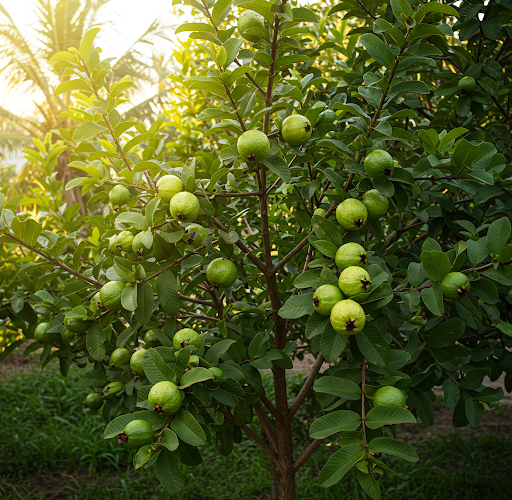How to Boost Guava Fruit Production in Your Garden or Container
If you’re struggling to get your guava tree to fruit, don’t worry! With the right care and techniques, you can encourage your guava tree to thrive and produce an abundant harvest year-round. Whether you’re growing a guava tree in your garden or a container, this guide will walk you through the steps to ensure healthy growth and a bountiful fruit crop.
Preparing the Soil and Fertilization
The first step to boosting your guava tree’s fruit production is proper fertilization. Guava trees need essential nutrients like phosphorus, calcium, potassium, and magnesium to thrive. One powerful ingredient to help with this is bone meal, which is rich in phosphorus and other minerals vital for root and fruit development. If you don’t have access to bone meal, an excellent alternative is wood ash (but only wood ash, not ashes from leaves). Wood ash is also rich in potassium and calcium, both of which are beneficial to your guava tree.
To begin, create a small circular trench around the base of the guava tree, leaving approximately 8 inches (20 cm) of space between the trunk and the trench. Add about 300 ml of bone meal into the trench and spread it evenly. After this, cover the bone meal with a layer of well-composted manure. Composted cattle manure is an excellent choice, but if you prefer, you can use worm castings or another type of organic compost. Spread about three handfuls of the manure over the bone meal, covering it entirely.
The manure will help decompose the bone meal and release vital nutrients into the soil, aiding the growth of your tree. Once you’ve added the compost, cover the trench with the surrounding soil to protect the organic matter and keep it from drying out too quickly.
Using Milk for Calcium
Guava trees, like many fruit trees, require adequate calcium to produce healthy fruit. A common issue with guava trees is the appearance of fruits with spots, holes, or deformities, which are often a result of calcium deficiencies. To provide your tree with a quick source of calcium, use milk. Milk, whether from a carton or a sachet, is rich in calcium and will quickly make it available to your tree.
In a container, mix 400 ml of water with four tablespoons of milk. Stir the mixture well and pour it around the base of the tree, making sure not to pour directly onto the trunk. It’s important to avoid applying fertilizer directly to the center of the root ball, as this could burn the plant’s roots. The calcium in the milk will be absorbed by the tree in about a week and will support better fruit development.
Watering and Care
Proper watering is essential to your guava tree’s success. Water the tree thoroughly after applying the milk and compost mixture, ensuring that the soil is well-moistened but not waterlogged. Be sure to allow the soil to dry out slightly between waterings. Guava trees prefer deep watering, so aim to water thoroughly but infrequently to encourage strong root development.
Encouraging Fruit Production Through Pruning
In order to stimulate fruiting, it’s essential to focus on the tree’s growth habits. One effective method for encouraging the production of lateral buds and flowers is pruning. By cutting back the tips of the branches, you can encourage the growth of lateral branches, which are often more fruitful than the main central stem.
To do this, simply pinch or trim the top of the branches, which will redirect the plant’s energy into the development of side branches that are more likely to produce flowers. You can prune any branches that are not bearing fruit, promoting the growth of new, more productive shoots. Be sure to prune during the growing season to allow the plant enough time to regenerate.
Providing Adequate Sunlight
For a guava tree to bear fruit successfully, it needs at least five hours of sunlight each day. This is essential for photosynthesis, which allows the tree to produce the energy it needs to grow and produce fruit. Ensure your guava tree is planted in a spot that receives plenty of sunlight, and avoid placing it in areas with too much shade or minimal light. If you’re growing your guava tree in a container, consider moving it to a sunny spot during the day.
Fertilization Schedule
Once the tree has been fertilized and watered, it’s important to maintain a regular fertilization schedule. Applying nutrients to the soil three to four times a year will ensure your guava tree has a steady supply of the minerals it needs to grow and fruit. The best times to fertilize are early spring, mid-summer, and fall, as these are the seasons when the tree is most actively growing.
For additional support, you can apply organic fertilizers such as compost or well-rotted manure between fertilization periods. This helps keep the soil enriched with beneficial microbes and organic matter, which support the tree’s health.
Harvesting Guavas
With proper care, your guava tree will begin to produce flowers and fruit in a few months. Depending on the variety, your tree may yield fruit several times a year, providing a steady supply of fresh guavas. As the fruit ripens, harvest it carefully to avoid damaging the tree. Guava fruits are typically ready to pick when they turn yellow or have a slight give when pressed.
Conclusion
With the right care, a guava tree can produce fruit all year round. By following these simple steps—providing proper nutrition, calcium, pruning, and sunlight—you’ll encourage a healthy, fruitful guava tree in no time. Whether you’re growing a guava tree in a container or in your garden, these techniques will help you achieve the best possible results for a thriving tree and delicious guavas.



